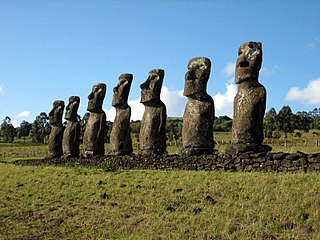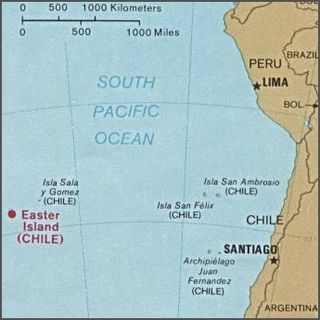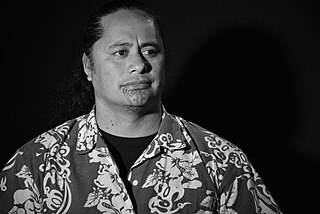Related Research Articles

Easter Island is an island and special territory of Chile in the southeastern Pacific Ocean, at the southeasternmost point of the Polynesian Triangle in Oceania. The island is most famous for its nearly 1,000 extant monumental statues, called moai, which were created by the early Rapa Nui people. In 1995, UNESCO named Easter Island a World Heritage Site, with much of the island protected within Rapa Nui National Park.

Hanga Roa is the main town, harbour and seat of Easter Island, a municipality of Chile. It is located in the southern part of the island's west coast, in the lowlands between the extinct volcanoes of Terevaka and Rano Kau.
The Williamson-Balfour Company was a Scottish owned Chilean company. Its successor company, Williamson Balfour Motors S.A., is a subsidiary of the British company Inchcape plc.

Rapa Nui National Park is a national park and UNESCO World Heritage Site located on Easter Island, Chile. Rapa Nui is the Polynesian name of Easter Island; its Spanish name is Isla de Pascua. The island is located in the southeastern Pacific Ocean, at the southeastern extremity of the Polynesian Triangle. The island was taken over by Chile in 1888. Its fame and World Heritage status arise from the 887 extant stone statues known by the name "moai", whose creation is attributed to the early Rapa Nui people who inhabited the island starting between 300 and 1200 AD. Much of the island has been declared as Rapa Nui National Park which, on 22 March 1996, UNESCO designated a World Heritage Site under cultural criteria (i), (iii), & (v). Rapa Nui National Park is now under the administrative control of the Ma´u Henua Polynesian Indigenous Community, which is the first autonomous institute on the island. The indigenous Rapa Nui people have regained authority over their ancestral lands and are in charge of the management, preservation and protection of their patrimony. On the first of December 2017, the ex-President Michelle Bachelet returned ancestral lands in the form of the Rapa Nui National Park to the indigenous people. For the first time in history, the revenue generated by the National Park is invested in the island and used to conserve the natural heritage.

Easter Island was traditionally ruled by a monarchy, with a king as its leader.

The Hanga Roa Stadium is a football stadium in Hanga Roa, the capital Easter Island a territory of Chile. It is the home ground of the CF Rapa Nui, the Easter Island football team. The stadium holds about 1,000 people.

Maunga Puna Pau is a small crater or cinder cone and prehistoric quarry on the outskirts of Hanga Roa in the south west of Easter Island. Puna Pau gives its name to one of the seven regions of the Rapa Nui National Park.

Geologically one of the youngest inhabited territories on Earth, Easter Island, located in the mid-Pacific Ocean, was, for most of its history, one of the most isolated. Its inhabitants, the Rapa Nui, have endured famines, epidemics of disease and cannibalism, civil war, environmental collapse, slave raids, various colonial contacts, and have seen their population crash on more than one occasion. The ensuing cultural legacy has brought the island notoriety out of proportion to the number of its inhabitants.

The Father Sebastian Englert Anthropological Museum is a museum in the town of Hanga Roa on Rapa Nui in Chilean Polynesia. Named for the Bavarian missionary, Fr. Sebastian Englert, OFM Cap., the museum was founded in 1973 and is dedicated to the conservation of the Rapa Nui cultural patrimony.
Juan Edmunds Rapahango was a Rapa Nui politician, the former Mayor of Hanga Roa, the municipality of Rapa Nui, in Chilean Polynesia. He is the son of Henry Percy Edmunds, director of the Williamson-Balfour Company, and Victoria Rapahango, an important native respondent for early ethnologists visiting the island. He is the father of the former mayor Pedro Pablo Edmunds Paoa. As mayor, Edmunds Rapahango promoted tourism to the island and helped to develop the island's infrastructure. He collaborated closely with William Mulloy and supported the American archaeologist's restoration projects. Edmunds Rapahango saw that Rapa Nui archaeology would play an important role the future of the island's economy.

The Holy Cross Church, also known as Hanga Roa Church or simply Catholic Church of Hanga Roa is the name of the religious building affiliated with the Catholic Church in the "Te Pito Te Henua" Street in the city of Hanga Roa, the capital and greater city of the Easter Island, a Territory of Chile in the Pacific Ocean.

Siméon or Timeone Riro ʻa Kāinga Rokoroko He Tau was the last ‘ariki (king) of Rapa Nui from 1892 until his death. He ruled the island during a brief period of indigenous autonomy between Chile's initial annexation in 1888 and the country's reassertion of colonial authority in 1896. Riro died unexpectedly during a diplomatic trip to Chile to discuss the island's sovereignty with colonial authorities, leading to suspicions that he had been poisoned.

Atamu Tekena or Atamu te Kena, full name Atamu Maurata Te Kena ʻAo Tahi was the penultimate ‘Ariki or King of Rapa Nui from 1883 until his death. He was appointed as the ruler in 1883 by the French Picpus missionaries in the island to represent their interest after a two decade interval in the native kingship caused by the disruptions of Westernization. Although a member of the Miru clan, traditionally associated with the native kingship, he was not a royal of the traditional patrilineal line of kings. In 1888, he signed a treaty of annexation ceding Easter Island to Chile in a ceremony officiated by Captain Policarpo Toro. His name is translated as "Adam the Gannet".

Angata, full name María Angata Veri Tahi ʻa Pengo Hare Koho was a Roman Catholic Rapa Nui religious leader from Easter Island during the late 19th and early 20th century. After experiencing a prophetic vision in which God instructed her to retake the land and livestock, she led an unsuccessful rebellion on the island against the Williamson-Balfour Company, intending to create a theocracy centered on Roman Catholicism and Rapa Nui spiritual values.

Lynn Rapu Tuki, head-teacher and founder of the Ma'aranui Cultural Academy and the Cultural Ballet Kari Kari, is an active promoter of the arts and traditions of the Rapa Nui People. He is Cultural Ambassador of Asia-Pacific and has been Head of the Liaison Office of the National Council of Culture and the Arts.
Jacobo Hey Paoa is the first Rapa Nui male to earn a law degree and become an attorney.
Moisés Jacob Tu‘u Hereveri was elected ‘ariki (king) of Rapa Nui from 1901 until 1902. He was the last Rapa Nui to claim the traditional kingship in the early 20th-century. However, he is not remembered as the last king instead his predecessor Riro Kāinga is generally regarded as the last king, although neither held much power. Variation of his family name included Hereveri, Here Veri, Veri-Veri, Beri-Beri, Tueri-Beri, Tueriveri, or Tueriveri.
Enrique Ika a Tuʻu Hati was elected ‘ariki (king) of Rapa Nui in 1900 and led a failed rebellion. He was one of the last Rapa Nui to claim the traditional kingship in the early 20th-century. However, he is not remembered as the last king instead his predecessor Riro Kāinga is generally regarded as the last king, although neither held much power.

The COVID-19 pandemic was confirmed to have reached the Chilean island and special territory of Easter Island in March 2020.

Isla de Pascua Department, also named Easter Island Department, was one of the departments of the historical province of Valparaíso before the "regionalization" of 1974. It was named after Easter Island and comprised such territory and the Sala y Gómez island.
References
- ↑ "Nayara Hangaroa | Leading Hotels of The World | Easter Island, Chile". Nayara Hangaroa. Retrieved 2022-11-20.
- ↑ "Rapa Nui y Hollywood: producción fílmica en Te Pito O Te Henua". 1library.co (in Mexican Spanish). Retrieved 2022-11-20.
- 1 2 Stanley, David (1 January 2000). South Pacific Handbook. David Stanley. p. 300. ISBN 978-1-56691-172-6 . Retrieved 16 July 2012.
- ↑ "Familia Schiess sella acuerdo con el clan Hito y pone fin a una década de disputa por el terreno del Hotel Hanga Roa | GDA – Grupo de Diarios América" (in European Spanish). Retrieved 2022-11-20.
- ↑ Gill, Nicholas; Pashby, Christie; Schreck, Kristina (16 June 2011). Frommer's Chile and Easter Island . John Wiley & Sons. p. 425. ISBN 978-1-118-10187-2 . Retrieved 16 July 2012.
- ↑ Connell, John; Rugendyke, Barbara (25 March 2008). Tourism at the Grassroots: Villagers and Visitors in the Asia-Pacific. Routledge. p. 52. ISBN 978-0-415-40555-3 . Retrieved 16 July 2012.
- ↑ "Nayara Resort asume comercialización del Hotel Hanga Roa". El Correo del Moai (in Spanish). Retrieved 2022-11-20.